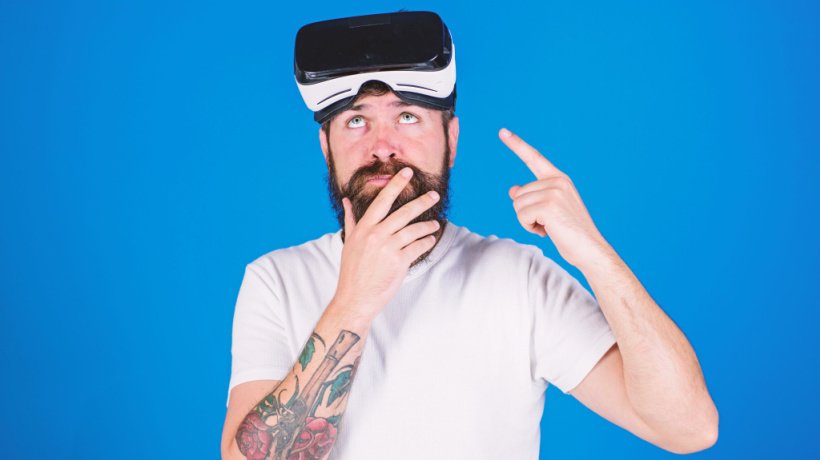Which Immersive Learning Challenges Should You Know About?
This article is part of a series that provides options for learning teams to quickly create immersive learning, including one that allows you to simultaneously practice using the software. What you are about to read is a fable. The company, AshCom, is fictional, but the learning challenges faced by Kathryn, AshCom’s CLO, and her team are real and commonly shared by learning teams in large organizations. It is our hope that you will be able to connect with the characters, their challenges, and the solutions they discover. We also invite you to read the first eBook in the series.

The After-Action Report
Kathryn hung up her phone and leaned back in her chair, uncertain where to begin. She had never been asked to write an “after-action report,” as Kurtis called it. She had seen them but didn’t review them carefully because they usually didn’t have anything to do with her or her learning team.
On her call with Kurtis, he said he was requesting it because AshCom had spent a lot of time, money, and resources on their first set of immersive technology experiences—far more than any learning effort in the past. Initial reports were that the immersive technology was a success, but Kurtis wanted details. Both he and Kathryn knew other requests would be coming for similar immersive experiences, so now was the moment to reflect on what happened, what worked well, what didn’t, and how they could improve if they decide to continue with Augmented and Virtual Reality.
Kathryn kept detailed notes over the months as the immersive learning experiences were being built. It was a habit she began years ago. She found that she missed opportunities for improvement because she could not remember all the details once a project was complete. At this moment, she was happy about this good practice.
She pulled out her notebook and sat at her conference table, which was close to the largest whiteboard in her office. She decided to begin with the big picture by putting the four immersive technology projects on the whiteboard.
Her first impression was an appreciation for the scope and scale of the projects. A significant number of people were involved. Her learning team worked with the MindSpring immersive team along with multiple divisions at AshCom to accomplish their objectives. The months since launch had been intense.
Kathryn opened her notebook and started at the beginning. She decided to read through everything without trying to draw any conclusions for the “after-action report” Kurtis had requested. As she read, some patterns began to emerge. Although there were four simultaneous projects, there were common characteristics. Patterns she was seeing emerged in all four projects.
As she started taking notes on the patterns, another thought struck her. These were her notes. What about all the others involved in the various projects? What could she learn from them? Did the patterns and experiences she was seeing match those of the people who had worked on the immersive experiences?
Kathryn decided she should have a series of quick conversations with some of the leaders of the projects. She would include members of her learning team, some of the leaders of the design and engineering division, the chief operating officer of AshCom who could address questions related to learning and maintenance, and some members of AshCom’s quality team. Finally, she wanted to talk to AshCom’s VP of sales to see how the medical device manufacturing company they were building the project for was performing. She would schedule these in the coming week.
Rather than having a free-ranging conversation, Kathryn decided she needed to focus the meetings by asking a series of questions to all.
- What were your apprehensions going into your project?
- What worked well for you and your team?
- What didn’t work well for you and your team?
- How can we improve the process if we create more immersive learning?
- How are these experiences being received by those going through them?
Kathryn was hoping to accomplish these conversations in the next week, but that didn’t happen. Setting meetings with more than a dozen people inside of a week was not realistic. One was on vacation. Others were unable to meet quickly because of their schedules. It ended up taking two weeks. She updated Kurtis, the CFO, of her process and told him it would take her a little longer than she anticipated. Kurtis told her he was not in a rush and would prefer it to be thorough rather than speedy.
When Kathryn completed her interviews, she again sat at her conference table. The four projects were still listed on her whiteboard. She had her progress notes, and she had the notes she had taken in her conversations with the various team members.
Apprehensions
When Kathryn first began discussing immersive technology with MindSpring, she had to make a choice. MindSpring had three options for how they would work together. The first was called “You Build,” in which Kathryn and her team would build the experiences themselves using MindSpring’s software. Because no one on her team had deep experience in building Augmented or Virtual Reality, she decided this was not a good option.
The second option was what MindSpring called “We Build,” in which MindSpring would build the experiences for Kathryn and AshCom. It would be more like a typical outsourcing project. This was a decent option for Kathryn, but she was concerned that when the projects were completed, her team would still lack experience in building anything in immersive technology.
The third option was what Kathryn ultimately chose. MindSpring called it “We Build Together.” The learning team from AshCom would work with the immersive technology team from MindSpring. The AshCom team would be introduced to the software and observe as assets were being created. As the projects progressed, AshCom would take a bigger role in the creation and the MindSpring team would serve more like coaches to them.
In her interviews with the AshCom team, she asked about each person’s apprehensions at the beginning of the projects. The responses were remarkably similar. Almost everyone experienced some level of anxiety because none of them had expertise in building anything in immersive technology. All knew that the stakes for this project were high because of the size of the medical device contract. Several people said their apprehensions were so high that they wondered if Kathryn was biting off more than she could chew. One member of her learning team, the youngest and most technologically savvy, said she had no apprehensions at all and could not wait to get started. Kathryn smiled to herself thinking about that conversation. She loved the enthusiasm.
What Worked Well
Most people interviewed said that their initial apprehensions proved to be less significant than they feared. When Kathryn asked for more specifics, she heard that the learning curve for using MindSpring’s technology was not as steep as they feared. The immersive team from MindSpring was responsive and patient, which gave those involved at AshCom the opportunity to gain experience, make mistakes, and move forward.
The learning team at AshCom said that they were impressed by the similarities between their process in making traditional elearning and the MindSpring process for creating immersive experiences. Kathryn’s instructional designers caught on quickly and were not required to learn an entirely new process. They began to look at Augmented Reality and Virtual Reality as simply additional tools in their toolbox. Their confidence and competency were high. They appreciated what MindSpring called their ‘one in/many out’ approach that enabled one asset to be delivered in an immersive format. They said that was a game-changer.
AshCom team members outside of the learning team said that they were amazed at what immersive technology could do. From the machine design team to operations to instruction to quality control, the response was the same. All saw many more possible applications of the technology to solve some of their problems. It was clear to Kathryn that many more requests for immersive learning would be coming her way.
What Didn’t Work Well
Some people Kathryn spoke to described struggling with the software. Because of its newness, it took them a while to grasp. Longer than they thought.
Two of the project leaders talked about the intensity of the building process. The iterative cycles of creation were fast. They had to react more quickly than they were used to. In other authoring tools, the options for what could be built were limited. In immersive technology, the options were truly unlimited. If they would conceive it, it could be built. While these two team members appreciated all the options, they sometimes found the choices overwhelming. When creating in VR, many more decisions had to be made, far more than they were used to. This meant that the time to complete was longer than they thought it would be.
Immersive Learning Challenges: How To Improve
Every person interviewed by Kathryn said that improvement would come with more exposure to the MindSpring software. They would get faster and better over time, and everyone hoped they would be able to continue working on immersive learning experiences.
Members of the learning team had two requests. The first was that Kathryn work with MindSpring to create an immersive sandbox where they could play with the software without it being related to any specific project. Kathryn told them she would work on this but was confident she would be able to provide this as long as everyone on her team kept up with their production schedule. Some of the most enthusiastic members of the learning team assured her that they would be experimenting with this on weekends. Maybe they would have a contest to see who could build the coolest experiences in Virtual Reality. Kathryn knew the power of this statement.
The second request of the learning team was that the immersive team from MindSpring be available to them if there was a next project. The learning team could learn much of the software by developing in it on their own time, but they wanted to use the MindSpring team to help them be even more creative. And MindSpring’s team could help them navigate the almost unlimited design options so they could create stronger experiences. Kathryn assured them that this request would be approved.
Learner Experiences
The people Kathryn spoke with were overwhelmingly positive about the experiences of the learners. The medical device company that originally contracted with AshCom to build the device and provide the immersive experience reported that their sales were brisk, faster than they anticipated. Much of this, they believed, was because buyers were able to experience the medical device virtually. They were able to see it virtually and see how it would be used in surgery. The stats of the device were impressive on their own. Patients healed more quickly. Surgeries were faster. The results were positive. Stats mattered, but so did the opportunity to see how the device would work in surgery.
Some learners struggled with vertigo and disorientation, especially in Virtual Reality. Added exposure did not seem to dissipate vertigo or improve the experience. While a minority of learners had these reactions, those who did could not be overlooked. Kathryn noted that if she and her team were going to build additional Virtual Reality learning experiences, they would need to provide the same learning experiences outside of Virtual Reality. She would need to track this carefully.
Conclusion
After Kathryn had written all the notes into the after-action report for Kurtis, she decided to add a concluding paragraph.
“Kurtis, the AshCom learning team is grateful for your trust in our ability to complete and deliver four immersive technology experiences. We know the stakes were high to get this right, so your confidence in my team means a great deal to them and me. There were some serious apprehensions at the start among the people involved, including me. Our teams faced challenges along the way, more intensely than on more typical projects. But our team rose to the occasion, and the MindSpring team led us where we needed to go. My conclusion is that immersive technology will play a significant role in our learning and development program going forward. I will be creating some MindSpring sandbox accounts for my team so they can continue to learn. We look forward to the next project and believe the results will, again, justify the use of these tools. Again, thank you for your faith in me and my team.”
Download the eBook Your Immersive Learning Launchpad: The Ultimate Guide To Launching XR Learning to discover how you can implement XR in your organization to make the most of modern tech and minimize on-the-job mistakes. You can also join the webinar to learn how to build incredible learning experiences in extended reality.
Dear Reader, if you're excited to learn more about how you can integrate immersive experiences into your learning strategy, schedule an XR Needs Assessment with a MindSpring Learning Expert. We’ll answer any questions you have and show you how we’ve successfully implemented immersion into learning.









